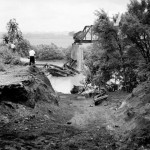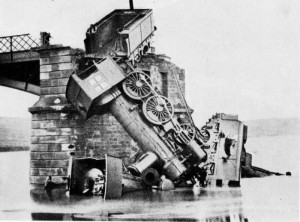 With all the rain we have been receiving, our area, along with many others have received multiple flash flood warnings, as well as flooding in many areas. When river water crosses a road, we are told not to drive through the flood, because it can take your car and cause your death. So many warnings are given to us in a flood situation. So much has been learned over the years about how to stay safe. So much has been learned about early warnings. So a lot of preparation is put in place, and yet, sometimes it’s just not enough. Such was the case on June 19, 1938.
With all the rain we have been receiving, our area, along with many others have received multiple flash flood warnings, as well as flooding in many areas. When river water crosses a road, we are told not to drive through the flood, because it can take your car and cause your death. So many warnings are given to us in a flood situation. So much has been learned over the years about how to stay safe. So much has been learned about early warnings. So a lot of preparation is put in place, and yet, sometimes it’s just not enough. Such was the case on June 19, 1938.
At that time, they didn’t have pickups that drove the rail system to check the tracks for problems. Instead a track walker was sent out to areas where there was a possible problem. Custer Creek is a small winding river that runs through 25 miles of the Great Plains on its way to the Yellowstone River. Minor streams like Custer Creek are prone to flash floods because their small capacity can quickly and easily be exceeded during heavy rains. A track walker was sent out to make sure everything was ok on the trestle at Custer Creek in Terry, Montana, and he reported that all was well there. Just a few hours later, a sudden downpour came through the area. The rising water in Custer Creek washed out the bridge and when the Olympian Special came through, it went crashing into the raging waters with no warning at all.
Two sleeper cars were immediately buried in the muddy waters, and the moonless night extremely hampered rescue efforts. In the end, 46 people lost their lives. The rear cars stayed above the water, but many passengers were seriously injured. To make matters worse, they could not be evacuated until the following morning. To hear of a train going into river in a flood is…at the very least, rare. I’ve heard of trains derailing…we all have, but this was different. On a moonless, pitch black night, my guess is that the engineer had no idea what  was about to happen. The shock must have been sickening to say the very least. Just knowing that people were going to die and there was nothing you could do about it, must have been the most horrible experience of an engineer’s life. Completely unimaginable.
was about to happen. The shock must have been sickening to say the very least. Just knowing that people were going to die and there was nothing you could do about it, must have been the most horrible experience of an engineer’s life. Completely unimaginable.
These days there are different safety measures in place, but that still doesn’t guarantee that such an event couldn’t happen again. I don’t know what the solution would be in these situations, but I’m sure that if there is one, technology will find a way to fix the problem. In those days, with the technology they had, they had done all they could, and yet, lives were still lost.


Leave a Reply